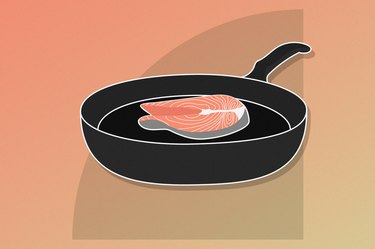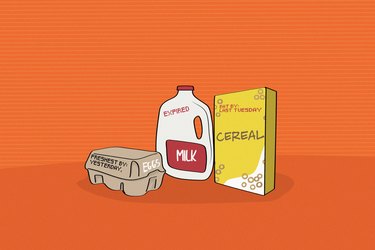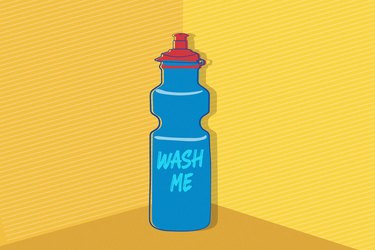
Whether you're searing scallops or baking pizza, cast-iron pans are a favorite among chefs for their versatility. But because they can be cooked under very high temperatures and may transfer iron to foods, some may be concerned about their potential health risks.
Still, people have cooked with cast-iron pans for hundreds of years, so how bad can they really be?
Video of the Day
Video of the Day
"Cast-iron cookware is strong, versatile and retains heat extremely well. Other cookware, like those made of aluminum, can wear down over time while cast-iron pans arguably get better with time," Abbie Gellman, RD, CDN, chef and author of The Mediterranean DASH Diet, tells LIVESTRONG.com.
"As you continue to use your cast-iron pan regularly, a coating slowly builds that is both tough and smooth and creates a durable, non-stick surface. This is called seasoned cast iron."
Here, we debunk some of the biggest myths about cast-iron cooking and provide tips on how to take care of your cookware so you can continue using it for years to come.
Seasoned vs. Enameled Cast-Iron Cookware
There are two main types of cast-iron cookware: Cast-iron skillets, which are seasoned pans with a non-stick surface, and Dutch ovens, which come with an enameled finish or without.
Like cast-iron skillets, enameled Dutch ovens are excellent for cooking a variety of dishes, including soups, pasta and sourdough bread. But because they have an enameled coating, they should be used only on the stove or in the oven — and not over a grill like you can with a seasoned cast-iron pan.
Whichever type of cast-iron pan or pot you choose, they both stand the test of time, helping you save money on cookware.
The Benefits of Cast-Iron Cookware
Because cast-iron cookware is an excellent conductor of heat, it can maintain high temperatures for long periods of time, promoting even cooking.
"In general, cooking with a cast-iron pan works well with many foods, from a piece of meat, poultry or fish to veggies," Gellman says. But cast-iron pans aren't only suited for savory dishes. Gellman notes that baking in a cast-iron skillet creates a crispy crust on baked goods, such as Dutch baby pancakes and cornbread.
Cast-iron cookware is particularly great for searing proteins, like seafood, beef, pork, poultry and even tofu. "You can sear the food over the stovetop and then transfer it to the oven to finish cooking or cook it entirely on the stove, depending on the food, cut and size," Gellman says.
Plus, they lend well to cooking ground meat indoors, like when you're preparing taco meat or burger patties, Gellman says. And if you're looking for a quick, flavorful way to prepare vegetables, you can use cast-iron pans to saute spinach, mushrooms, bell peppers and whatever produce you have on hand. Just season with some of your favorite spices — and voila, a nutritious side dish.
"Cast iron lends itself to healthy, lower-calorie cooking methods that keep food lean and doesn't require much oil, like water-based methods, including poaching and braising, as well as grilling and quick broiling," say Lyssie and Tammy Lakatos, RDN, CDN, founders of The Nutrition Twins and authors of The Nutrition Twins' Veggie Cure.
"Another major benefit is that when you choose cast iron instead of non-stick cookware, you'll avoid PFOA (perfluorooctanoic acid), which is a possible carcinogen."
Is the Iron in Cast Iron Unsafe?
One of the biggest concerns with cooking with cast-iron pans is that because they can transfer a certain amount of iron to your food, it can be harmful to your health. (Iron is a mineral that produces a protein called hemoglobin, which carries oxygen to red blood cells throughout the body.)
But Gellman says that the amount of iron that transfers to food from cast-iron pans is very minimal because they are seasoned.
"Most people are cooking with a seasoned cast iron, which does not leach a significant amount of iron into foods. Therefore, cooking with cast iron should not be considered as an iron supplement or replacement for consuming iron-rich foods," Gellman explains.
That said, using an unseasoned or poorly seasoned cast-iron pan could contribute more iron, but that amount isn't clear. Plus, cooking acidic foods, like tomatoes and citrus, may leach more iron from the pan because they can strip the seasoning, Gellman says. But again, most people are using highly seasoned pans, so this shouldn't be too much of a concern.
Plus, having a little more iron in your food can actually be a good thing for most people. "It's estimated that as many as 25 percent of the world's population is anemic (iron deficient), and vegans, pre-menopausal people, pregnant people and children are most at risk. So these people often really need an iron boost," the Lakatos twins say.
A widely cited November 2018 study in the Journal of Public Health and Nutrition looked at the differences in iron content in chickpeas and beets cooked in a non-iron pan versus a cast-iron pan, and found that cast-iron pans increased the iron content in both foods.
In the cast-iron pan, 5 grams of chickpeas contained 0.06 milligram of iron versus 0.053 milligrams when cooked in the non-iron pain. The same serving of beets contained 0.0081 milligrams after cast-iron cooking versus 0.007 milligrams after cooking in the non-iron pan.
It Might Be a Concern for People With Hemochromatosis
A rare instance that cast-iron cooking can pose a danger is if you live with a condition called hemochromatosis, which causes your body to absorb too much iron from the foods you eat, according to the Mayo Clinic.
Having hemochromatosis can cause your body to store excess amounts of iron in your organs, particularly in your liver, heart and pancreas, putting you at risk for life-threatening health issues, such as liver disease, heart problems and diabetes.
Hemochromatosis is a hereditary condition, but most people don't experience signs and symptoms until mid-life — after age 40 for people assigned male at birth and after age 60 for people assigned female at birth, per the Mayo Clinic. For example, post-menopausal people may experience symptoms because they no longer lose iron during their periods.
"If someone has blood relatives with the disease, they can get tested to see if they have it," the Lakatos twins say.
Can Cast-Iron Cooking Cause Cancer?
There's some concern that because cast-iron pans can sustain high heat, they may produce chemicals known as heterocyclic amines (HCAs) and polycyclic aromatic hydrocarbons (PAHs), which are linked to an increased risk of cancer.
These chemicals form when meat, including beef, pork, fish and chicken, are cooked using high-temperature cooking techniques, like pan-frying and grilling over an open flame, according to the National Cancer Institute.
But Gellman says the risks of PAHs and HCAs are primarily only a concern when grilling foods. PAHs form when the fat and juices from meat drip over an open fire or hot surface, causing flames and smoke. PAHs are in the smoke and then adhere to the surface of the meat, according to the National Cancer Institute.
"They [cast-iron pans] can withstand high heat, but that doesn't mean you are cooking stovetop or in an oven at a temperature that is high enough to be concerned with carcinogens," Gellman explains.
"This is typically only an issue when grilling. Grilling creates extremely high temperatures, charring and fat dripping into flames. These are the main problems when looking at carcinogens. Cooking indoors with a cast-iron pan should not create any of these carcinogenic-causing issues."
Tip
Meat that's cooked in temperatures above 300°F or cooked for a long time tends to form more HCAs, per the National Cancer Institute.
So if you're cooking meat in cast iron over a grill, there's a chance you could be exposing yourself to some PAHs and HCAs.
"Any time you cook meat at a high temperature, it is likely that PAHs and HCAs are being formed," the Lakatos twins say. "The good news is that there are several things you can do to reduce your exposure to these carcinogens, like not allowing the meat to get cooked too well. The more meat gets dried out, the more HCAs you get."
You can also cook meat in a microwave before putting it in the cast-iron cookware to limit the amount of time that the meat is exposed to the high temperature, the Lakatos twins say.
Another thing to note is that studies have not established a clear link between HCA and PAH exposure from cooked meats and cancer in humans, per the National Cancer Institute. Most studies that have linked HCAs and PAHs to cancer are in animal models, and the doses the mice were given are a thousand times higher than what a person would eat in a normal diet.
So, Is It Bad to Cook With Cast Iron?
No, it's actually pretty good. Unless you live with a health condition like hemochromatosis, which forces you to be more aware of your iron intake, you don't have to worry about being exposed to too much iron from cast iron.
And if you're concerned about PAHs and HCAs forming in your foods, cooking with cast iron at home isn't likely going to bear many risks. PAHs and HCAs tend to form only when cooking under very high temperatures, such as when grilling or pan-frying.
If you're cooking meat with cast iron over a grill, you can reduce your exposure to PAHs and HCAs by avoiding cooking it until it's too well-done or popping it in the microwave for a few minutes before cooking it in cast iron.
The only downsides to cooking with cast iron are that the pans are heavy and get very hot, including the handle, so you have to cook with care.
"It's important to have appropriate dry kitchen towels and/or potholders at all times. Depending on the size of the cast iron, it may also be helpful to hold both sides when moving it on the stove or transferring it in and out of the oven," Gellman says.
How to Season a Cast-Iron Pan
If not cared for properly, cast iron can rust, so you want to make sure you're keeping it well-seasoned, Gellman says. Whether you have some rust in your cast-iron pan or want to season a new one, here's how to do it:
- Turn the oven on at 500°F.
- Coat the inside and outside of the pan with a tablespoon of oil, such as olive or avocado oil, using a piece of paper towel.
- Pace the pan upside down in the oven for an hour and allow it to cool in the oven or on the stove.



